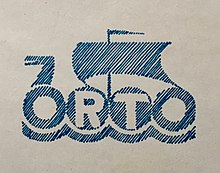ORTO (publisher)
ORTO was an exile Estonian publisher that existed from 1944 to 1973.
founding
On July 12, 1944 , the writers Karl Ristikivi and Valev Uibopuu , who had fled from Estonia , met in Helsinki with the entrepreneur Andres Laur (1908–1973), who had also fled, to discuss how to supply the Estonian soldiers in Finnish hospitals with reading material . They decided to re-publish Ristikivi's novel Tuli ja raud ('Fire and Iron', 1938). Laur took over the costs and distribution, Ristikivi the proofreading. A Swedish-Estonian and Estonian-Swedish dictionary was also printed at the same time. When the books were printed, however, the political situation had changed as a result of Finland's armistice with the Soviet Union , so that many Estonians preferred to flee further to Sweden to be on the safe side. The registration of the publisher took place on November 10, 1944 in Vadstena .
In 1949 a new publishing house was built near Gothenburg , where Laur is said to have led a rather luxurious life. In the fall of 1950, however, for fear of the outbreak of World War III, Laur prepared the relocation of the publishing house and printer to Toronto , which also took place in 1951.
Publications
A total of 405 books were published at ORTO , and Laur also published a magazine and newspaper. The first two titles were published in Helsinki, from the third book onwards the publications bear the place of publication Vadstena, although Helsinki could still figure as the place of printing in later publications . In 1950 the books were published in Gothenburg, sometimes also in Vadstena. From 1951 only Toronto appears as the place of publication.
ORTO was primarily concerned with conveying literature and initially published both Estonian classics ( Anton Hansen Tammsaare , Oskar Luts , Kalevipoeg ) and many well-known exile authors such as August Gailit , Bernard Kangro , August Mälk and Valev Uibopuu . After the founding of the Estonian Writers' Cooperative (1950), the focus was on literature translated into Estonian, the 145 titles, i.e. H. made up almost 36%. Within this group, in turn, the focus was on Finnish authors, who made up almost a third. Mika Waltari alone published 18 books in Estonian translation.
With the death of the publisher Andres Laur on April 3, 1973 the publishing activities were stopped. Laur's extensive archive, which is a valuable source of research into Estonian exile literature , is located in the National Library of Canada in Ottawa .
Polemics
Since the publisher had a monopoly position within the Estonian exile community in its early days, the publisher did not have to worry too much about the interests of the authors, which resulted in low fees. This led to resentment and ultimately to the establishment of his own writers' cooperative in Sweden, especially since Laur had relocated his headquarters to Canada. In turn, Laur reacted extremely hostile, which led to a polemic between him and the majority of the exiled authors who remained in Sweden. Laur defamed the authors who had moved away from him, who in turn reacted with incomprehension: “Time and again, all ORTO publications attempt to disparage the works published by the Estonian Writers' Cooperative, even though their authors are the same as the ORTO when they wrote their books with him published as the best Estonian writers. ”Until his death Laur could not forgive the Estonian writers for setting up their own cooperative and accused them of doing the Estonian exile community a disservice.
Secondary literature
- Vallo Kelder: ORTO Soome-side kirjastaja ja tõlkija kirjades, in: Raamat on… I. Tallinn: Tallinna Bibliofiilide Klubi 2000, pp. 141–153. (Summary: Publishing house ORTO and its Finnish connection, pp. 153–154)
- Piret Noorhani: Konverents “Andres Laur 100” Eesti Kirjandusmuuseumis, in: Keel ja Kirjandus 8–9 / 2008, pp. 750–751.
- Hannes Oja : Kirjastus ORTO tegevus Kanadas, in: Raamat on… I. Tallinn: Tallinna Bibliofiilide Klubi 2000, pp. 155–161. (Summary: Publishing house ORTO in Canada, p. 161)
- Anne Valmas: Edukas ja kõmuline "Orto", in: Keel ja Kirjandus 9/1993, 548-560.
- Anne Valmas: Eestlaste kirjastus tegevus välismaal 1944–2000. I. Tallinn: Tallinna Pedagoogikaülikool 2003. 204 pp.
- Anne Valmas: Eestlaste kirjastus tegevus välismaal 1944–2000. II. Raamatukataloog. Tallinn: Tallinna Pedagoogikaülikool 2003. 397 pp.
- Anne Valmas: ORTO kirjastuse väljaanded, in: Raamat on… I. Tallinn: Tallinna Bibliofiilide Klubi 2000, pp. 162–180. (= Complete bibliography of all published publisher titles.)
Individual evidence
- ↑ Anne Valmas: Eestlaste Kirjastus tegevus välismaal 1944-2000. I. Tallinn: Tallinna Pedagoogikaülikool 2003, p. 42.
- ↑ Anne Valmas: Eestlaste Kirjastus tegevus välismaal 1944-2000. I. Tallinn: Tallinna Pedagoogikaülikool 2003, p. 43.
- ↑ Hannes Oja: Kirjastus ORTO tegevus Kanadas, in: Raamat on… I. Tallinn: Tallinna Bibliofiilide Klubi 2000, p. 157.
- ↑ Piret Noorhani: Konverents “Andres Laur 100” Eesti Kirjandusmuuseumis, in: Keel ja Kirjandus 8–9 / 2008, p. 750.
- ^ For example, in August Gailit: Isade maa. Romaan. Teine cloudy. Eesti kirjastus "ORTO". Andres Laur. Vadstena Rootsi, where the inside cover says: Painoteollisuus Oy. Helsinki 1946, d. H. a Finnish printing company.
- ↑ Vallo Kelder: ORTO Soome-side kirjastaja ja tõlkija kirjades, in: Raamat on… I. Tallinn: Tallinna Bibliofiilide Klubi 2000, pp. 141–153.
- ↑ Anne Valmas: Edukas yes kõmuline "Orto", in: Keel yes Kirjandus 9/1993, S. 549th
- ↑ Agu Kase avalik kiri, in: Tulimuld 2/1955, p. 125.
- ↑ Anne Valmas: Eestlaste Kirjastus tegevus välismaal 1944-2000. I. Tallinn: Tallinna Pedagoogikaülikool 2003, p. 100.

